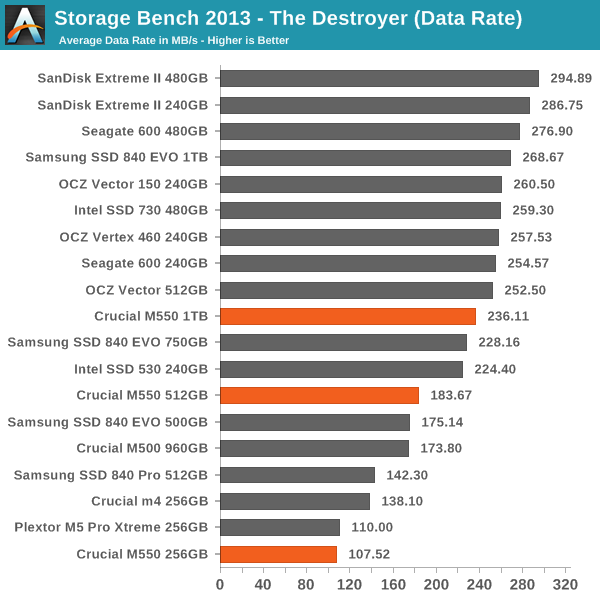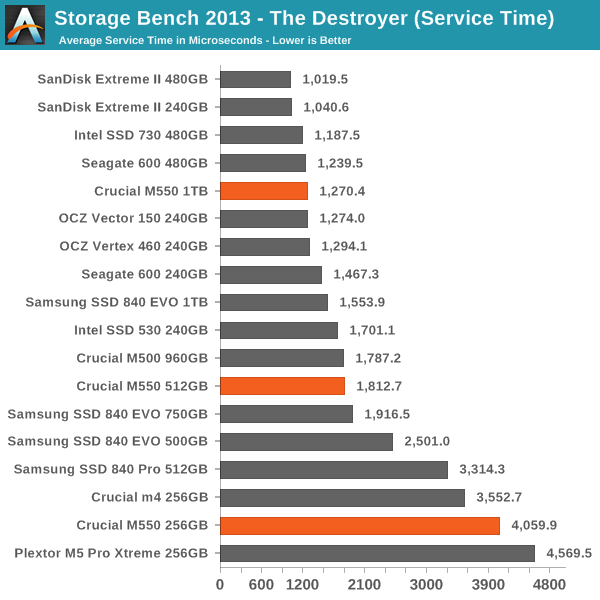Crucial M550 Review: 128GB, 256GB, 512GB and 1TB Models Tested
by Kristian Vättö on March 18, 2014 8:00 AM ESTAnandTech Storage Bench 2013
Our Storage Bench 2013 focuses on worst-case multitasking and IO consistency. Similar to our earlier Storage Benches, the test is still application trace based—we record all IO requests made to a test system and play them back on the drive we're testing and run statistical analysis on the drive's responses. There are 49.8 million IO operations in total with 1583.0GB of reads and 875.6GB of writes. As some of you have asked, I'm not including the full description of the test for better readability, so make sure to read our Storage Bench 2013 introduction for the full details.
| AnandTech Storage Bench 2013 - The Destroyer | ||
| Workload | Description | Applications Used |
| Photo Sync/Editing | Import images, edit, export | Adobe Photoshop CS6, Adobe Lightroom 4, Dropbox |
| Gaming | Download/install games, play games | Steam, Deus Ex, Skyrim, Starcraft 2, BioShock Infinite |
| Virtualization | Run/manage VM, use general apps inside VM | VirtualBox |
| General Productivity | Browse the web, manage local email, copy files, encrypt/decrypt files, backup system, download content, virus/malware scan | Chrome, IE10, Outlook, Windows 8, AxCrypt, uTorrent, AdAware |
| Video Playback | Copy and watch movies | Windows 8 |
| Application Development | Compile projects, check out code, download code samples | Visual Studio 2012 |
We are reporting two primary metrics with the Destroyer: average data rate in MB/s and average service time in microseconds. The former gives you an idea of the throughput of the drive during the time that it was running the test workload. This can be a very good indication of overall performance. What average data rate doesn't do a good job of is taking into account response time of very bursty (read: high queue depth) IO. By reporting average service time we heavily weigh latency for queued IOs. You'll note that this is a metric we've been reporting in our enterprise benchmarks for a while now. With the client tests maturing, the time was right for a little convergence.

The relatively poor IO consistency shows up in our Storage Bench 2013 as well. We are looking at about Samsung SSD 840 EVO level performance here (when taking the difference in over-provisioning into account), which is certainly a step up from the M500 but in the end the M550 is just a mediocre performer.











100 Comments
View All Comments
hojnikb - Thursday, March 20, 2014 - link
Thats only taking flash endurance into account. That doesn't mean controller wont crap on you years sooner.q.epsilon.p - Sunday, April 6, 2014 - link
Dude given that the 500M 480 and 550M 512 models are so different in price and so similar in performance I would go for the 480BG.Although the 500m 240 and 500m 120 perform much slower, but they were always slower compared to the competition so you had that information available before buying them. But considering its write speed where they really suffered I wouldn't have been much concerned.
and tbh you are not really going to notice the difference without benchmarks and the price difference is big enough to make it worth it.
Homeles - Tuesday, March 18, 2014 - link
The M500 being phased out doesn't make sense. Technically the M500 is more advanced with its 128Gb dies, despite its slower performance.elerick - Tuesday, March 18, 2014 - link
At first glance I tend to agree that this is a middle of the pack SSD. I however do seriously consider the power loss protection worth its weight in gold. I have a Samsung 830 and these days I value reliability above "good enough" performance. Once PCI-E SSD starts producing consumer priced drives I'll go that route.Death666Angel - Friday, March 21, 2014 - link
Can we boot off PCIe SSDs yet (consumer grade Windows)?hojnikb - Tuesday, March 18, 2014 - link
I really expected better consistency, but well... Maybe next time (or next firmware update ?).Although its nice to see they were able to boost write speed so much. Looks like smaller dies do pay off.
PS:
Anyone knows what native write accelaration stands for ? At first i though it was something like turbowrite (not knowing they will use 64Gbit flash) but this does not appear to be the case ...
Kristian Vättö - Tuesday, March 18, 2014 - link
Crucial specifically said they don't have an SLC or DRAM buffer and the write performance should be the same across all LBAs (the HD Tach graph shows that this is true). To me it sounds like the Native Write Acceleration is just a marketing trick aimed at Samsung and others who use buffers to boost performance.hojnikb - Tuesday, March 18, 2014 - link
Yeah it appears so.It really nice to see, that they aren't using any nasty tricks like turbowrite, just to inflate numbers.
jospoortvliet - Thursday, March 20, 2014 - link
I think turbowrite is an awesome idea - it helps exactly where consumers need it... Short write bursts. Sure, not that interesting for pro use perhaps but isn't that the point of consumer products?hojnikb - Thursday, March 20, 2014 - link
Awsome idea for marketing department maybe. Considering that your avarage joe only looks at the sequential speeds, it makes EVO compared to lets say m500 a way way better drive, even though in reality thats not the case.Its not like turbowrite is bad or anything (i think it a great solution for "slow" write devices such as TLC) but i just hate that they are fooling people (they could easily market both normal speeds and turbo speeds)